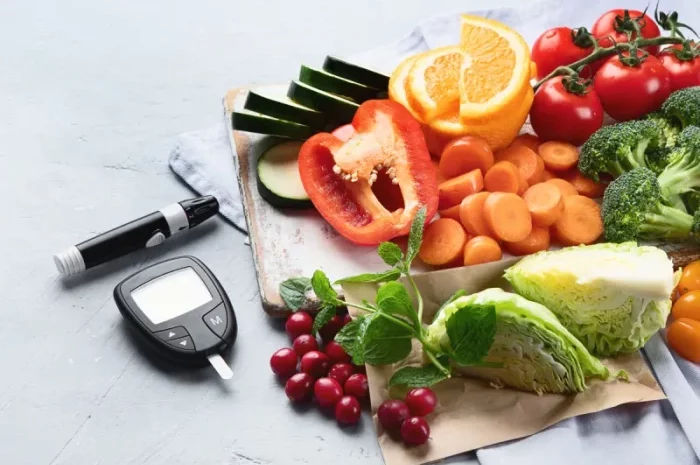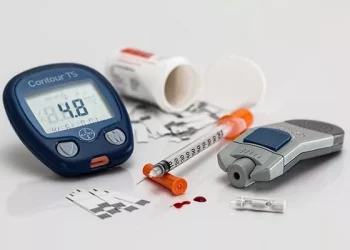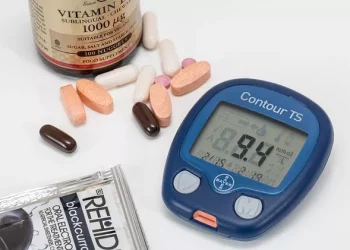Diabetes is a chronic condition that affects millions of people worldwide, influencing how the body processes glucose (sugar). One of the most important aspects of managing diabetes is maintaining healthy blood sugar levels, and diet plays a pivotal role in achieving this goal. The right foods can help lower blood sugar levels, manage insulin sensitivity, and reduce the risk of complications associated with the disease. While there is no single “magic food” to cure diabetes, a well-balanced diet that focuses on whole, nutrient-dense foods can significantly improve overall health and help lower blood sugar levels.
In this article, we will explore the various foods that are beneficial for people with diabetes, explain how these foods work to control blood sugar, and provide practical dietary tips that can be incorporated into daily life. Understanding the relationship between food and diabetes management is key to taking control of the condition and improving long-term outcomes.
The Importance of a Diabetes-Friendly Diet
Before diving into the specific foods that help lower diabetes, it is important to understand the general principles behind a diabetes-friendly diet. People with diabetes need to manage their blood sugar levels effectively. Poor diet choices can lead to fluctuations in glucose levels, putting individuals at risk for complications such as nerve damage, kidney disease, heart disease, and vision problems.
A diabetes-friendly diet should:
Control Blood Sugar Levels: This involves balancing the intake of carbohydrates, fats, and proteins to prevent blood sugar spikes.
Promote Insulin Sensitivity: Eating foods that help improve the body’s response to insulin can help control blood sugar levels more effectively.
Provide Essential Nutrients: A balanced diet ensures that individuals with diabetes get the vitamins, minerals, and fiber they need to maintain good health.
Foods That Lower Blood Sugar in Diabetes
There are certain foods that have been scientifically shown to help manage blood sugar levels. These foods typically have a low glycemic index (GI), are rich in fiber, and contain healthy fats and proteins that help stabilize blood sugar levels over time. Below are some of the best foods to include in a diabetes-friendly diet.
1. Leafy Greens and Non-Starchy Vegetables
Leafy greens such as spinach, kale, Swiss chard, and collard greens are excellent additions to a diabetes-friendly diet. These vegetables are low in carbohydrates, high in fiber, and packed with essential nutrients such as vitamins A, C, K, and folate. The high fiber content in these vegetables helps slow the absorption of sugar into the bloodstream, preventing blood sugar spikes.
Other non-starchy vegetables, including broccoli, cauliflower, zucchini, and bell peppers, are also beneficial for blood sugar control. These vegetables are naturally low in calories and carbohydrates, making them an ideal choice for individuals looking to manage their weight and blood sugar levels.
Why They’re Good: Leafy greens and non-starchy vegetables have a low glycemic index, meaning they have little effect on blood sugar levels. The fiber they contain helps slow the absorption of glucose, leading to better blood sugar control.
2. Whole Grains
Whole grains, such as quinoa, brown rice, barley, and oats, are rich in fiber and have a lower glycemic index compared to refined grains like white rice, white bread, and pasta. The fiber in whole grains slows down the digestion process, which helps regulate blood sugar levels and provides a steady source of energy throughout the day.
Additionally, whole grains are a good source of important minerals such as magnesium and potassium, which play a role in regulating blood sugar levels. Studies have shown that consuming whole grains can improve insulin sensitivity and reduce the risk of developing Type 2 diabetes.
Why They’re Good: Whole grains are rich in soluble fiber, which helps improve insulin sensitivity and control blood sugar levels. Unlike refined grains, whole grains are digested more slowly, preventing rapid blood sugar spikes.
3. Nuts and Seeds
Nuts and seeds, such as almonds, walnuts, chia seeds, flaxseeds, and pumpkin seeds, are great additions to a diabetes-friendly diet. These foods are rich in healthy fats, fiber, and plant-based protein. They are also packed with antioxidants, which can help reduce inflammation and improve heart health—an important consideration for individuals with diabetes.
Nuts and seeds have a low glycemic index and help regulate blood sugar levels by slowing the absorption of carbohydrates. Additionally, they promote satiety, reducing the risk of overeating and helping with weight management.
Why They’re Good: The healthy fats, fiber, and protein in nuts and seeds help control blood sugar levels and improve overall heart health. They also provide long-lasting energy without causing spikes in blood sugar.
4. Legumes
Legumes, such as beans, lentils, chickpeas, and peas, are rich in fiber, protein, and complex carbohydrates, making them an excellent choice for people with diabetes. The fiber in legumes helps slow down the absorption of sugar into the bloodstream, preventing rapid increases in blood glucose. Additionally, legumes have a low glycemic index, making them less likely to cause blood sugar spikes.
Consuming legumes regularly has been shown to improve insulin sensitivity and reduce fasting blood sugar levels. Moreover, legumes are an affordable and versatile source of plant-based protein.
Why They’re Good: Legumes are nutrient-dense foods that help lower blood sugar levels due to their high fiber content. They also improve insulin sensitivity and provide a sustainable source of energy.
5. Berries
Berries, such as strawberries, blueberries, raspberries, and blackberries, are rich in antioxidants, vitamins, and fiber. These fruits have a low glycemic index and are low in carbohydrates compared to other fruits. Berries are also packed with anthocyanins, compounds that have been shown to improve insulin sensitivity and reduce inflammation.
The fiber in berries helps slow the absorption of sugar into the bloodstream, while the antioxidants help protect the body from oxidative stress, which is commonly elevated in people with diabetes.
Why They’re Good: Berries are low in sugar, high in fiber, and packed with antioxidants, all of which contribute to better blood sugar control. Their anti-inflammatory properties also support overall health.
6. Fish High in Omega-3 Fatty Acids
Fatty fish such as salmon, mackerel, sardines, and trout are rich in omega-3 fatty acids, which have been shown to have numerous health benefits for individuals with diabetes. Omega-3s help reduce inflammation, improve heart health, and may also help regulate blood sugar levels.
Eating fish high in omega-3s can improve insulin sensitivity, lower triglyceride levels, and reduce the risk of heart disease, which is a common complication of diabetes. Omega-3s also support healthy brain function and reduce the risk of cognitive decline.
Why They’re Good: Omega-3 fatty acids help reduce inflammation and improve insulin sensitivity. Fatty fish are also an excellent source of lean protein, which helps stabilize blood sugar levels.
7. Cinnamon
Cinnamon is a spice that has been shown to have beneficial effects on blood sugar regulation. Studies have indicated that cinnamon can help improve insulin sensitivity and lower fasting blood sugar levels. Cinnamon works by mimicking insulin’s effect on the body, allowing cells to take in glucose more efficiently.
Adding cinnamon to your diet can be as simple as sprinkling it on oatmeal, adding it to smoothies, or using it in cooking. However, it’s important to consume cinnamon in moderation, as large amounts may have negative effects on liver function.
Why It’s Good: Cinnamon has been shown to improve insulin sensitivity, lower fasting blood sugar, and reduce the risk of Type 2 diabetes. Its anti-inflammatory properties also support overall health.
8. Apple Cider Vinegar
Apple cider vinegar (ACV) has been used for centuries for its health benefits, and recent studies suggest it may be particularly beneficial for people with diabetes. ACV can help improve insulin sensitivity and lower blood sugar levels after meals. It works by slowing the digestion of starches, preventing rapid increases in blood glucose.
To incorporate apple cider vinegar into your diet, consider diluting it in water and drinking it before meals or using it as a salad dressing.
Why It’s Good: ACV helps lower blood sugar by improving insulin sensitivity and slowing the absorption of carbohydrates. It also has antimicrobial properties and supports digestive health.
Tips for a Diabetes-Friendly Diet
In addition to including the foods mentioned above, it’s important to follow certain dietary principles to help manage blood sugar levels effectively:
Control Portion Sizes: Eating large portions, even of healthy foods, can lead to excessive calorie intake and elevated blood sugar levels. Use portion control strategies to avoid overeating.
Eat Regular Meals: Consuming regular meals throughout the day helps prevent large fluctuations in blood sugar. Aim for three balanced meals with healthy snacks in between.
Choose Low-Glycemic Foods: Focus on foods with a low glycemic index, as they have a minimal effect on blood sugar levels.
Limit Processed and Refined Foods: Processed foods, such as sugary snacks, refined grains, and fast food, can cause blood sugar spikes and should be limited or avoided.
Drink Water: Staying hydrated is essential for managing blood sugar levels. Avoid sugary beverages and opt for water, herbal teas, or unsweetened beverages instead.
Conclusion
Diet plays a crucial role in managing diabetes and lowering blood sugar levels. By incorporating foods that are high in fiber, healthy fats, and plant-based protein, and by avoiding processed and high-sugar foods, individuals with diabetes can significantly improve their blood sugar control. A diabetes-friendly diet not only helps manage blood sugar levels but also supports overall health and reduces the risk of complications.
Incorporating the foods listed in this article, such as leafy greens, whole grains, nuts, seeds, legumes, berries, fatty fish, cinnamon, and apple cider vinegar, can be a powerful tool in the management of diabetes. However, it is important to remember that diet is just one aspect of diabetes management. Regular physical activity, medication, and monitoring blood sugar levels are also essential components of a comprehensive diabetes care plan.
Consult with a healthcare professional or dietitian to create a personalized nutrition plan that meets your individual needs, and take proactive steps to lower blood sugar and maintain optimal health. By making informed dietary choices, individuals with diabetes can enjoy better control of their condition and lead a healthier, more fulfilling life.
Related topics:
Can You Fix Diabetes with Diet?
























